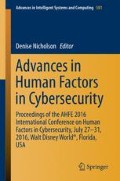Abstract
As more concentrations in cybersecurity in the computer science undergraduate curriculum are being offered to meet a high demand, these offerings have not reflected a major concern of cybersecurity researchers, namely that there is little emphasis on the behavioral questions involved in the study and analysis of cybersecurity events. To this end, Howard University has introduced an upper division undergraduate course and graduate course to complement its cybersecurity course offerings, called “Behavioral Cybersecurity.” The behavioral approach also includes considerations of human factors. This paper reviews the course development, pedagogical choices made, and outcomes of its initial offering.
Access this chapter
Tax calculation will be finalised at checkout
Purchases are for personal use only
Notes
- 1.
Peter Hilton was portrayed in “The Imitation Game,” only called “Peter” in the dialogue, but listed in the credits for the actor Matthew Beard in the role of “Peter Hilton.”.
- 2.
Association of American Colleges and Universities TIDES Project, Leona M. and Harry B. Helmsley Charitable Trust (#21044PG-EDU023).
- 3.
Courtesy of Shenick Alcine.
- 4.
The name of a former Major League Baseball player, Harry Arthur (Cookie) Lavagetto, 1912–1990.
References
National Centers of Academic Excellence in Information Assurance National Security Agency. https://www.nsa.gov/ia/academic_outreach/nat_cae/index.shtml
SONY Pictures Releasing, The Imitation Game (film) (2014)
National Science Foundation. http://www.nsf.gov/statistics/degrees/
Setalvad, A.: Demand to fill cybersecurity jobs booming. Peninsula Press, Stanford Journalism Program, Stanford, CA (2015)
Stamp, M.: Information Security: Principles & Practice. Wiley, Hoboken (2011)
Herreid, C.F., Schiller, N.A.: Case studies and the flipped classroom. J. Coll. Sci. Teach., National Science Teachers Association 42(5) (2013)
University of Central Florida. www.graduatecatalog.ucf.edu/programs/program.aspx?id=11981
Mitnick, K.D., Simon, W.: The Art of Intrusion, Wiley Publishing, NY (2005)
Miller, G.: The magical number seven, plus or minus two: some limits on our capacity for processing information. Psychol. Rev. 63, 81–97 (1956)
Baron-Cohen, S.: The essential difference: men, women, and the extreme male brain, Penguin, ISBN 0141011017 (2003)
Turing, A., Braithwaite, R., Jefferson, G., Newman, M.: Can automatic calculating machines be said to think? In: Copeland, J. (ed.) The Essential Turing. Oxford Press, Oxford (1952)
Best, J.: IBM Watson: the inside story of how the Jeopardy-winning supercomputer was born, TechRepublic. http://www.techrepublic.com/article/ibm-watson-the-inside-story-of-how-the-jeopardy-winning-supercomputer-was-born-and-what-it-wants-to-do-next/
Gilbert, D.: If only gay sex caused global warning, Los Angeles Times, Vol. 7, no. 2 (2006)
http://acqnotes.com/acqnote/tasks/element-3-assess-and-document-risk
The Myers-Briggs Foundation. Gainesville, FL. http://www.myersbriggs.org/my-mbti-personality-type/mbti-basics/
Vigfusson, Y.: private communication
Sweeney, L.: Simple demographics often identify people uniquely. Data Privacy Working Paper 3. Carnegie Mellon University, Pittsburgh (2000)
Lee, J.: Cybersecurity: a new concentration in computer science (to appear)
Author information
Authors and Affiliations
Corresponding author
Editor information
Editors and Affiliations
Rights and permissions
Copyright information
© 2016 Springer International Publishing Switzerland
About this paper
Cite this paper
Patterson, W., Winston, C., Fleming, L. (2016). Behavioral Cybersecurity: Human Factors in the Cybersecurity Curriculum. In: Nicholson, D. (eds) Advances in Human Factors in Cybersecurity. Advances in Intelligent Systems and Computing, vol 501. Springer, Cham. https://doi.org/10.1007/978-3-319-41932-9_21
Download citation
DOI: https://doi.org/10.1007/978-3-319-41932-9_21
Published:
Publisher Name: Springer, Cham
Print ISBN: 978-3-319-41931-2
Online ISBN: 978-3-319-41932-9
eBook Packages: EngineeringEngineering (R0)

